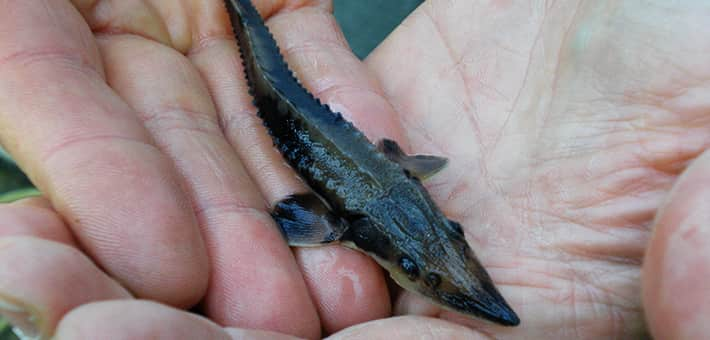Approved Great Lakes Restoration Initiative Grants for Great Lakes Basin Fish Habitat Partnership Projects Announced
OutdoorHub 08.15.13

The U.S. Fish and Wildlife Service and the Great Lakes Basin Fish Habitat Partnership are pleased to announce the approval of nearly $400,000 in grants aimed at supporting on-the-ground fish habitat work in the Great Lakes region under the Great Lakes Restoration Initiative and the National Fish Habitat Partnership. The Partnership received 28 proposals requesting nearly $2 million to implement habitat restoration projects throughout the Great Lakes. Natural resource managers from around the region selected a total of eight projects based on how well projects addressed priority threats identified in the Great Lakes Basin Fish Habitat Partnership Strategic Plan, and how well they restored or protected ecological and hydrologic functions of aquatic habitats.
“We are pleased to support these projects to benefit aquatic habitat under the Partnership, and recognize the Great Lakes Restoration Initiative as a tremendous opportunity to implement on-the-ground restoration in the basin,” said Todd Turner, Midwest Assistant Regional Director of Fisheries.
Complete descriptions of selected projects are available on the Great Lakes Basin Fish Habitat Partnership website at http://greatlakes.fishhabitat.org/.
2013 Great Lakes Basin Fish Habitat Partnership projects include:
Michigan:
Trout Unlimited was granted $27,128 to restore stream habitat in Cedar Creek in the Rogue River Watershed. A portion of Cedar Creek runs through the city of Cedar Springs. The creek is impacted by the city’s stormwater runoff, which has negatively impacted instream habitat. Restoration techniques at this site will include installation of large woody debris and restoration of the riparian area.
The Conservation Resource Alliance was granted $65,000 for the Little Manistee River Channel Restoration Project. Eroding streambanks, road crossings, stream channel aggradation, intense recreational use, and development are a few factors that currently threaten the Little Manistee River. This project will improve aquatic habitat by converting a half mile of straight, shallow and excessively wide stream to one with added channel complexity, stable riffle and pool habitat, and natural sediment transport.
The Ionia Conservation District was granted $75,000 to restore the Grand River Restoration at Lyons. The 13 foot tall Lyons Dam stretches 280 feet across the Grand River, which is one of Michigan’s largest watersheds. This project will use natural channel design in the removal of the Lyons Dam, and restore the Grand River to match natural conditions and recreate connected floodplains.
The Conservation Resource Alliance was granted $37,437 for the Northern Michigan Regional In-Stream Habitat Initiative. Large woody debris is a vital, naturally occurring component of healthy stream ecosystems. Through habitat assessments, project partners have identified priority stream reaches that lack woody debris in a 15 county area of Michigan’s northern lower peninsula. This project will install whole trees and LUNKER® structures to increase pool habitat at priority sites.
Ohio:
The Ottawa Soil and Water Conservation District was granted $74,000 to restore hydrologic connectivity and fish passage at the Toussaint Marsh in the Maumee Area of Concern. The Toussaint Marsh is a one of the few remaining wetland complexes in the Lake Erie basin, and it has been severely impaired by impoundments and the resulting lack of water exchange that maintains healthy wetland ecosystems. Fish access to high quality wetland habitat is also limited at this site. In this project, the dike of the impounded wetland will be breached and replaced with a water control structure to hydrologically reconnect 738 acres of coastal marsh to Lake Erie. The project works to improve at least three identified Beneficial Use Impairments.
Minnesota:
The Wolf Ridge Environmental Learning Center was granted $43,050 to restore fish passage on Sawmill Creek, a designated trout stream that feeds into the Baptism River, a tributary to Lake Superior. The existing culverts will be replaced with a new box culvert that will allow fish species to move upstream in all flow conditions. The project will be monitored and viewed by the over 14,000 visitors to Wolf Ridge annually.
Wisconsin:
The Ashland County Land and Water Conservation Department was granted $30,000 to restore brook trout habitat in City Creek. City Creek is a tributary to Devil’s Creek, a class 1 trout stream and designated state fishery area in the Upper Bad River watershed of Lake Superior. Habitat in City Creek is limited by excessive sediment loading from failed culverts that cover the stream bed with fine materials, degrading spawning substrates. This project will replace culverts and stabilize an eroding stream bank to restore natural stream hydrology and allow for fish passage.
New York:
The Erie County Soil and Water Conservation District was granted $42,000 to improve habitat in Spring Brook, a highly fertile tributary to the Cattaraugus Creek in the Lake Erie basin. The lack of large riparian trees at the site near Springville prevents shading to maintain cool water temperatures and recruitment of large woody debris for fish cover. This project will plant shrubs and trees in the riparian area to reduce sedimentation, increase stream shading, reduce water temperatures and increase large wood for fish habitat along 2,500 linear feet of stream.
The grants were awarded under the Great Lakes Basin Fish Habitat Partnership, administered by the U.S. Fish and Wildlife Service, a bureau of the Department of the Interior. The grants were funded by the President’s 2013 Budget which provided $300 million for the Environmental Protection Agency –led, interagency Great Lakes Restoration Initiative. For more information on U.S. Fish and Wildlife Service activities related specifically to the Great Lakes Restoration Initiative, please visit http://www.fws.gov/GLRI.
The Great Lakes Basin Fish Habitat Partnership (http://greatlakes.fishhabitat.org/) is a recognized partnership of the National Fish Habitat Action Plan (http://www.fishhabitat.org/) and was formed to make habitats whole and accessible for fish and other aquatic organisms, from headwater streams to deep lake habitats. For more information about the National Fish Habitat Action Plan, its partnerships and programs, please visit http://www.fishhabitat.org.

